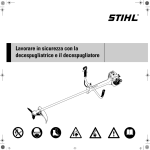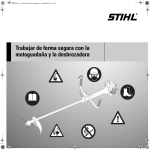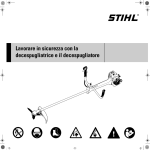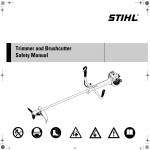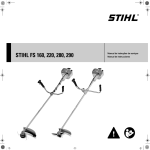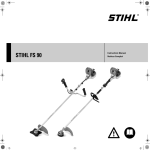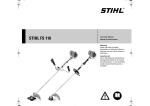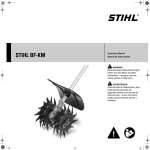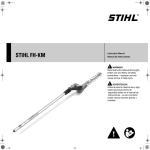Download Trimmer and Brushcutter Safety Manual
Transcript
{
Trimmer and Brushcutter Safety
Manual
English
Safety Precautions and Working
Techniques
Maintenance and Care
Main Parts
2
11
13
© ANDREAS STIHL AG & Co. KG, 2009
0457-187-0121. M2-5.E9.FST.
0000000742_001_GB
This manual contains the safety
precautions and recommended working
techniques outlined in the instruction
manuals for STIHL trimmers and
brushcutters.
The chapter on "Main Parts and
Controls" shows the FS 130 as an
example. Other trimmers and
brushcutters may have different parts
and controls.
This manual contains references to
various chapters in the model-specific
instruction manuals.
Printed on chlorine-free paper
Printing inks contain vegetable oils, paper can be recycled.
Original Instruction Manual
Contents
You should therefore always refer to the
instruction manual of your particular
trimmer or brushcutter model.
The approved combinations of cutting
attachment, deflector, handle and
harness are particularly important. Use
only the combinations approved in the
model-specific instruction manual.
Please contact your STIHL dealer if you
have any questions after reading this
manual.
{
Trimmer and Brushcutter Safety Manual
1
English
Safety Precautions and
Working Techniques
Some special safety precautions must be
observed to reduce the
risk of personal injury
when operating this
power tool because of the
very high speed of its cutting attachment.
It is important you read
and understand the
instruction manual before
using your unit for the
first time and keep the
manual in a safe place for
future reference. Nonobservance of the safety
precautions may result in
serious or even fatal
injury.
Observe all applicable local safety
regulations, standards and ordinances.
If you have not used this type of power
tool before: Have your dealer or other
experienced user show you how to
operate your power tool or attend a
special course in its operation.
Minors should never be allowed to use a
power tool.
Keep bystanders, especially children,
and animals away from the work area.
When the power tool is not in use, shut it
off so that it does not endanger others.
Secure it against unauthorized use.
The user is responsible for avoiding
injury to third parties or damage to their
property.
2
Do not lend or rent your power tool
without the instruction manual. Be sure
that anyone using it understands the
information contained in this manual.
The use of noise emitting power tools
may be restricted to certain times by
national or local regulations.
To operate the power tool you must be
rested, in good physical condition and
mental health.
If you have any condition that might be
aggravated by strenuous work, check
with your doctor before operating a
power tool.
Persons with pacemakers only: The
ignition system of your power tool
produces an electromagnetic field of a
very low intensity. This field may
interfere with some pacemakers. To
reduce health risks, STIHL recommends
that persons with pacemakers consult
their physician and the pacemaker
manufacturer before operating this tool.
Do not operate the power tool if you are
under the influence of any substance
(drugs, alcohol) which might impair
vision, dexterity or judgment.
Depending on the cutting attachment
fitted, use your brushcutter only for
cutting grass, wild growth, shrubs,
scrub, bushes, small diameter trees and
similar materials.
It must not be used for any other
purpose because of the increased risk of
accidents and damage to the machine.
Never attempt to modify your power tool
in any way since this may result in
accidents or damage to the machine.
Only use cutting attachments and
accessories that are explicity approved
for this power tool model by STIHL or
are technically identical. If you have any
questions in this respect, consult a
servicing dealer. Use only high quality
parts and accessories in order to avoid
the risk of accidents and damage to the
machine.
STIHL recommends the use of genuine
STIHL replacement parts. They are
specifically designed to match your
model and meet your performance
requirements.
Never attempt to modify your power tool
in any way since this may increase the
risk of personal injury. STIHL excludes
all liability for personal injury and
damage to property caused while using
unauthorized attachments.
Do not use a pressure washer to clean
the unit. The solid jet of water may
damage parts of the unit.
The deflector on this power tool cannot
protect the operator from all objects
thrown by the cutting attachment
(stones, glass, wire, etc.). Such objects
may ricochet and then hit the operator.
Clothing and Equipment
Wear proper protective clothing and
equipment.
Clothing must be sturdy
but allow complete freedom of movement. Wear
snug-fitting clothing, an
overall and jacket combination, do not wear a
work coat.
Trimmer and Brushcutter Safety Manual
English
Avoid clothing that could get caught on
branches or brush or moving parts of the
machine. Do not wear a scarf, necktie or
jewelry. Tie up and confine long hair
(e.g. with a hair net, cap, hard hat, etc.).
Do not fuel a hot engine – fuel may spill
and cause a fire.
Transporting the Power Tool
Open the fuel cap carefully to allow any
pressure build-up in the tank to release
slowly and avoid fuel spillage.
Wear steel-toed safety
boots with non-slip soles.
Fuel your power tool only in wellventilated areas. If you spill fuel, wipe
the machine immediately – if fuel gets on
your clothing, change immediately.
Your power tool comes standard with
either a screw-type or bayonet-type fuel
cap.
Wear a safety hard hat
for thinning operations,
when working in high
scrub and where there is
a danger of head injuries
from falling objects. To
reduce the risk of injury
from thrown objects,
always wear a face shield
and safety glasses.
A face shield alone does not provide
adequate eye protection.
Wear hearing protection, e.g. earplugs
or ear muffs.
Wear heavy-duty gloves.
002BA079 KN
Sturdy shoes with non-slip soles may be
worn as an alternative only when using
mowing heads.
Always turn off the engine.
Carry the unit hanging from the shoulder
strap or properly balanced by the drive
tube. Fit transport guard on metal cutting
attachments to avoid the risk of injury
from blade contact
Transporting in a vehicle: Properly
secure your power tool to prevent
turnover, fuel spillage and damage.
Fueling
STIHL offers a comprehensive range of
personal protective clothing and
equipment.
Gasoline is an
extremely flammable
fuel. Keep clear of naked
flames. Do not spill any
fuel – do not smoke.
Always shut off the engine.before
refueling.
Trimmer and Brushcutter Safety Manual
After fueling, tighten
down the screw-type fuel
cap as securely as
possible.
Insert the fuel cap with
hinged grip (bayonet-type
cap) correctly in the
opening, turn it clockwise
as far as stop and fold the
grip down.
This reduces the risk of unit vibrations
causing the fuel cap to loosen or come
off and spill quantities of fuel.
To reduce the risk of serious or fatal
burn injuries, check for fuel leakage. If
fuel leakage is found, do not start or run
the engine until leak is fixed.
Before Starting
Check that your power tool is properly
assembled and in good condition – refer
to appropriate chapters in the instruction
manual.
3
English
Use only an approved combination
of cutting attachment, deflector,
handle and harness. All parts must
be assembled properly and
securely.
–
Slide control / stop switch must
move easily to STOP or 0
–
Smooth action of throttle trigger
interlock (if fitted) and throttle trigger
– the throttle trigger must return
automatically to the idle position.
–
Check that the spark plug boot is
secure – a loose boot may cause
arcing that could ignite combustible
fumes and cause a fire.
–
Cutting tool or attachment: Check
for correct and secure assembly
and good condition.
–
Check protective devices (e.g.
deflector for cutting tool, rider plate)
for damage or wear. Always replace
damaged parts. Do not operate your
machine with a damaged deflector
or worn rider plate (lettering and
arrows no longer legible).
–
Never attempt to modify the controls
or the safety devices in any way.
–
Keep the handles dry and clean –
free from oil and dirt – for safe
control of the power tool.
–
Adjust the harness and handle(s) to
suit your height and reach. See
chapters on "Fitting the Harness"
and "Balancing the
Trimmer/Brushcutter".
To reduce the risk of personal injury,
do not operate your power tool if it is
damaged or not properly assembled.
4
If you use a shoulder strap or full
harness: Practise removing and putting
down the machine as you would in an
emergency. To avoid damage, do not
throw the machine to the ground when
practising.
Starting the Engine
Check idle speed setting: The cutting
attachment must not rotate when the
engine is idling with the throttle trigger
released.
To reduce the risk of fire, keep hot
exhaust gases and hot muffler away
from easily combustible materials (e.g.
wood chips, bark, dry grass, fuel).
Start the engine at least 3 meters from
the fueling spot, outdoors only.
Holding and Controlling the Unit
Place the unit on firm ground in an open
area. Make sure you have good balance
and secure footing. Hold the unit
securely. The cutting attachment must
be clear of the ground and all other
obstructions because it may begin to run
when the engine starts.
Always hold the unit firmly with both
hands on the handles.
Your brushcutter is a one-person unit.
To reduce the risk of injury from
thrown objects, do not allow other
persons within a radius of 15 meters of
your own position – even when starting.
To reduce the risk of
injury, avoid contact with
the cutting attachment.
Make sure you always have good
balance and secure footing.
Models with bike handle
002BA055 KN
–
Right handle on control handle, left hand
on left handle.
Do not drop start the
power tool – start the
engine as described in
the instruction manual.
Note that the cutting
attachment continues to
run for a short period
after you let go of the
throttle trigger – flywheel effect.
Trimmer and Brushcutter Safety Manual
English
002BA080 KN
Models with loop handle
On units with a loop handle and barrier
bar, left hand on loop handle, right hand
on control handle, even if you are lefthanded.
Check and correct the idle speed setting
at regular intervals. If the cutting
attachment still rotates at idle speed,
have your dealer make proper
adjustments or repairs.
To reduce the risk of serious or fatal
injury from breathing toxic fumes,
ensure proper ventilation when working
in trenches, hollows or other confined
locations.
Take special care in slippery conditions
– damp, snow, ice, on slopes or uneven
ground.
To reduce the risk of accidents, stop
work immediately in the event of
nausea, headache, visual disturbances
(e.g. reduced field of vision), problems
with hearing, dizziness, deterioration in
ability to concentrate. Apart from other
possibilities, these symptoms may be
caused by an excessively high
concentration of exhaust gases in the
work area.
Watch out for obstacles: Roots, tree
stumps or holes which could cause you
to trip or stumble.
Make sure you always have good
balance and secure footing.
During Operation
Always stand on the ground while
working, never on a ladder, work
platform or any other insecure support.
In the event of impending danger or in
an emergency, switch off the engine
immediately by moving the slide control
/ stop switch to STOP or 0.
Be particularly alert and cautious when
wearing hearing protection because
your ability to hear warnings (shouts,
alarms, etc.) is restricted.
15m (50ft)
To reduce the risk of personal injury ,
do not allow any other persons within a
radius of 15 meters of your own position.
To reduce the risk of damage to
property, also maintain this distance
from other objects (vehicles, windows).
The correct engine idle speed is
important to ensure that the cutting
attachment stops rotating when you let
go of the throttle trigger.
Trimmer and Brushcutter Safety Manual
To reduce the risk of accidents, take a
break in good time to avoid tiredness or
exhaustion.
Work calmly and carefully – in daylight
conditions and only when visibility is
good. Stay alert so as not to endanger
others.
Your power tool produces
toxic exhaust fumes as
soon as the engine is
running. These fumes
may be colorless and
odorless and contain
unburned hydrocarbons
and benzol. Never run
the engine indoors or in
poorly ventilated locations, even if your model
is equipped with a catalytic converter.
Operate your power tool so that it
produces a minimum of noise and
emissions – do not run the engine
unnecessarily, accelerate the engine
only for cutting.
To reduce the risk of fire, do not
smoke while operating or standing near
your power tool. Note that combustible
fuel vapor may escape from the fuel
system.
The dusts, vapor and smoke produced
during operation may be dangerous to
health. If the work area is very dusty or
smoky, wear a respirator.
If your power tool is subjected to
unusually high loads for which it was not
designed (e.g. heavy impact or a fall),
always check that it is in good condition
before continuing work – see also
"Before Starting".
Check the fuel system in particular for
leaks and make sure the safety devices
are working properly. Do not continue
operating your power tool if it is
5
English
damaged. In case of doubt, have the
machine checked by your servicing
dealer.
Do not operate your power tool with the
starting throttle lock engaged – engine
speed cannot be controlled in this
position.
To reduce the risk
of injuryfrom
thrown objects,
never operate the
unit without the
proper deflector for
the type of cutting
attachment being
used.
Check the work area:
Stones, pieces of metal
or other solid objects can
be thrown and cause personal injury or damage
the cutting attachment
and property (e.g. parked
vehicles, windows).
Special care must be taken when
working in difficult, over-grown terrain.
When cutting high scrub, under bushes
and hedges: Keep cutting tool at
minimum height of 15 cm to avoid
harming small animals.
–
Turn off the engine. Hold
brushcutter firmly and wait for the
cutting attachment to come to a
standstill.
–
Check condition and tightness, look
for cracks.
–
Check sharpness.
–
Replace damaged or dull cutting
attachments immediately.
Clean grass and plant residue off the
cutting attachment mounting at regular
intervals – remove any build up of
material from the cutting attachment and
deflector.
To reduce the risk of injury, shut off
the engine before replacing the cutting
attachment.
Do not continue using or attempt to
repair damaged or cracked cutting
attachments by welding, straightening or
modifying the shape (out of balance).
This may cause parts of the cutting
attachment to come off and hit the
operator or bystanders at high speed
and result in serious or fatal injuries.
When using mowing heads
Before leaving the power tool
unattended: Shut off the engine.
Equip the deflector with the additional
components specified in the instruction
manual.
Check the cutting attachment at regular
short intervals during operation or
immediately if there is a noticeable
change in cutting behavior:
Use only the deflector with properly
mounted line limiting blade to ensure the
mowing lines are automatically trimmed
to the approved length.
To reduce the risk of injury, always
turn off the engine before adjusting the
nylon line of manually adjustable
mowing heads
6
Using the unit with over-long nylon
cutting lines reduces the motor's
operating speed. The clutch then slips
continuously and this causes
overheating and damage to important
components (e.g. clutch, polymer
housing components) – and this can
increase the risk of injury from the
cutting attachment rotating while the
engine is idling.
When using metal cutting tools
STIHL recommends the use of original
STIHL metal cutting attachments. They
are specifically designed to match your
model and meet your performance
requirements.
Metal cutting attachments rotate at very
high speed. The forces that occur act on
the machine, the attachment and the
material being cut.
Sharpen metal cutting attachments
regularly as specified.
Unevenly sharpened metal cutting
attachments cause out-of-balance
which can impose extremely high loads
on the machine and increase the risk of
breakage.
Dull or improperly sharpened cutting
edges can put a higher load on the
cutting attachment and increase the risk
of injuryfrom cracked or broken parts.
Inspect metal cutting attachments for
cracks or warping after every contact
with hard objects (e.g. stones, rocks,
pieces of metal). To reduce the risk of
injury, remove burrs and other visible
build-ups of material (use a file) because
they may become detached and be
thrown at high speed during operation.
Trimmer and Brushcutter Safety Manual
English
To reduce the above-mentioned risks
when using a metal cutting attachment,
never use a metal cutting attachment
with a diameter larger than specified. It
must not be too heavy. It must be
manufactured from materials of
adequate quality and its geometry must
be correct (shape, thickness).
To reduce the risk of injury, a metal
cutting attachment not manufactured by
STIHL must not be heavier, thicker,
have a different shape or a diameter
larger than the largest metal cutting
attachment approved by STIHL for this
power tool model.
Vibrations
Prolonged use of the power tool may
result in vibration-induced circulation
problems in the hands ("white finger
disease").
No general recommendation can be
given for the length of usage because it
depends on several factors.
The period of usage is prolonged by:
–
Hand protection (wearing warm
gloves)
–
Work breaks
The period of usage is shortened by:
–
Any personal tendency to suffer
from poor circulation (symptoms:
frequently cold fingers, tingling
sensation)
–
Low outside temperatures
–
Amount of gripping force (holding
the power tool tightly restricts
circulation)
Trimmer and Brushcutter Safety Manual
Users who use the machine periodically
or for long periods or users who
repeatedly experience corresponding
symptoms (e.g., tingling sensation in
fingers), should undergo a medical
examination.
Maintenance and Repairs
Service the machine regularly. Do not
attempt any maintenance or repair work
not described in the instruction manual.
Have all other work performed by a
servicing dealer.
STIHL recommends that you have
servicing and repair work carried out
exclusively by an authorized STIHL
servicing dealer. STIHL dealers are
regularly given the opportunity to attend
training courses and are supplied with
the necessary technical information.
Only use high-quality replacement parts
in order to avoid the risk of accidents
and damage to the machine. If you have
any questions in this respect, consult a
servicing dealer.
STIHL recommends the use of genuine
STIHL replacement parts. They are
specifically designed to match your
model and meet your performance
requirements.
To reduce the risk of injury, always shut
off the engine before carrying out any
maintenance or repairs or cleaning the
machine. – Exception: Carburetor and
idle speed adjustments.
Do not turn the engine over on the
starter with the spark plug boot or spark
plug removed unless the slide control /
stop switch is on STOP or 0 since there
is otherwise a risk of fire from
uncontained sparking.
To reduce the risk of fire, do not service
or store your machine near open flames.
Check the fuel filler cap for leaks at
regular intervals.
Use only a spark plug of the type
approved by STIHL and make sure it is
in good condition – see "Specifications".
Inspect the ignition lead (insulation in
good condition, secure connection).
Check the condition of the muffler.
To reduce the risk of fire and damage
to hearing, do not operate your
machine if the muffler is damaged or
missing.
Do not touch a hot muffler since burn
injury will result.
Vibration behavior is influenced by the
condition of the AV elements – check the
AV elements at regular intervals.
Symbols on Deflectors
An arrow on the deflector shows the
correct direction of rotation of the cutting
attachments.
Some of the following symbols are
applied to the outside of the deflector to
indicate the approved combination of
cutting attachment and deflector.
Deflector may be used
with mowing heads.
7
English
Deflector may be used
with grass cutting blades.
Shoulder strap / Harness
Mowing Head with Nylon Lines
Do not use deflector with
brush knives, shredder
blades or circular saw
blades.
Do not use deflector with
brush knives, shredder
blades, grass cutting
blades or circular saw
blades.
Deflector may be
used with mowing heads. Not
approved for use
with brush
knives, shredder
blades or circular
saw blades.
Deflector may be
used with mowing heads – do
not use metal cutting attachments.
8
N
Use a harness conforming to the
approved combinations of cutting
attachment, deflector, handle and
harness in the model-specific
instruction manual.
N
With the engine running, attach the
machine to the harness.
000BA015 KN
Deflector must not be
used with mowing heads.
The following applies within the
European Union (EU):
Grass cutting blades, brush knives
and shredder blades must always be
used in combination with a shoulder
strap or full harness.
Circular saw blades must always be
used in combination with a full harness
with a quick-action release system.
For trimming around fence posts, trees,
etc. – less risk of damaging tree bark.
To reduce the risk of injury,
never use steel wire in place of
the nylon cutting line.
STIHL Polycut Mowing Head with
Polymer Blades
For mowing unobstructed edges of
meadows (without posts, fences, trees
or similar obstacles).
Check the wear limit marks!
Trimmer and Brushcutter Safety Manual
English
Resharpen the grass cutting blade
according to instructions when it has
dulled noticeably.
002BA177 KN
002BA135 KN
Brush Knife
If one of the wear limit marks on the
PolyCut mowing head is worn through
(arrow): Do not continue using the
mowing head. Install a new one. There
is otherwise a risk of injury from thrown
parts of the head.
The risk of kickout is greatest when
the black area of the rotating cutting
attachment comes into contact with a
solid object.
Grass Cutting Blade
002BA066 KN
It is important to follow the maintenance
instructions for the Polycut mowing
head.
Risk of Kickout (Blade Thrust) with
Metal Cutting Attachments
To cut wild growth and scrub, lower the
brush knife down onto the growth to
achieve shredding effect – do not use
the cutting attachment above waist
height.
When using metal cutting attachments
(grass cutting blade, brush knife,
shredder blade, circular saw blade)
there is a risk of kickout when the
rotating blade comes into contact with a
solid object such as a tree trunk, branch,
tree stump, rock or similar. The machine
is thrown to the right or to the rear –
opposite to the attachment's direction of
rotation.
000BA020 KN
Exercise extreme caution when using
this method of cutting. The higher the
cutting attachment is off the ground, the
greater the risk of injury from cuttings
being thrown sideways.
Use for grass and weeds only – sweep
the brushcutter in an arc like a scythe.
Improper use may damage the
grass cutting blade – risk of
injury from thrown parts.
Trimmer and Brushcutter Safety Manual
Suitable for cutting matted grass, wild
growth and scrub, thinning young stands
with a maximum stem diameter of 2 cm.
To reduce the risk of personal injury,
never attempt to cut thicker wood.
Use the brushcutter like a scythe (sweep
it to the right and left) at ground level
when cutting grass and thinning young
stands.
Warning! Improper use of a brush knife
may cause it to crack, chip or shatter –
risk of injury from thrown parts.
To reduce the risk of injury it is essential
to take the following precautions
9
English
Avoid contact with stones, rocks,
pieces of metal and other solid
foreign objects.
Warning! Improper use may damage the
shredder blade – risk of injury from
thrown parts.
–
Never cut wood or shrubs with a
stem diameter of more than 2 cm –
use a circular saw blade for this
purpose.
To reduce the risk of injury it is essential
to take the following precautions:
–
–
Inspect the brush knife at regular
short intervals for signs of damage.
Do not continue working with a
damaged brush knife.
Resharpen the brush knife regularly
(when it has dulled noticeably) and
have it balanced if necessary
(STIHL recommends a STIHL
servicing dealer).
Shredder Blade
Suitable for thinning and shredding
tough, matted grass and scrub.
–
Avoid contact with stones, rocks,
pieces of metal and other solid
foreign objects.
–
Never cut wood or shrubs with a
stem diameter of more than 2 cm.
–
Inspect the shredder blade at
regular short intervals for signs of
damage. Do not continue working
with a damaged shredder blade.
–
Resharpen the shredder blade
when it has dulled noticeably and
have it balanced if necessary (by
servicing dealer).
Circular Saw Blade
For cutting shrubs and trees:
Up to a stem diameter of 4 cm when
used on brushcutters.
Up to a stem diameter of 7 cm when
used on clearing saws.
To cut wild growth and scrub, lower the
shredder blade down onto the growth to
achieve shredding effect – do not use
the cutting attachment above waist
height.
Before starting the cut, accelerate the
engine up to full throttle. Perform cut
with uniform pressure.
Use circular saw blades only with a
matching limit stop of the correct
diameter.
To reduce the risk of blade
damage, avoid contact with
stones and the ground.
Resharpen the blade properly in
good time – dull teeth may result
in the blade cracking and
shattering and causing serious
injury.
When felling, maintain a distance of at
least two tree lengths from the next
felling site.
Risk of kickout
002BA068 KN
–
The risk of kickout is highest in the black
area of the blade: Do not use this area of
the circular saw blade for cutting.
There is also a risk of kickout when
using the lighter shaded areas of the
blade: These areas of the blade should
only be used by experienced operators
with specialized training.
STIHL recommends that you use the
non-shaded area of the circular saw
blade. Always start the cut with this area
of the blade.
Exercise extreme caution when using
this method of cutting. The higher the
cutting attachment is off the ground, the
greater the risk of injury from cuttings
being thrown sideways.
10
Trimmer and Brushcutter Safety Manual
English
Complete machine
Control handle (top handle)
Air filter
Pickup body in fuel tank
Visual inspection (condition, leaks)
X
Clean
X
X
Check operation
X
X
Clean
X
Replace
X
X
Check
X
Replace
X
Fuel tank
Clean
Carburetor
Check idle adjustment – the cutting
attachment must not turn
X
X
X
X
Cooling inlets
Spark arresting screen1) in muffler
X
X
Readjust electrode gap
X
Replace after every 100 operating hours
Visual inspection
X
Clean
X
Check2)
Clean or replace
X
2)
X
X
All accessible screws and nuts (not adjustRetighten
ing screws)
Antivibration elements
Check
X
X
X
Replace2)
Visual inspection
Cutting attachment
X
X
Readjust idle
Spark plug
if required
if damaged
if problem
every 12 months
monthly
weekly
after each refueling stop
before starting work
The following intervals apply to normal operating conditions only. If your daily working time is longer or operating conditions are difficult (very dusty work area, etc.),
shorten the specified intervals accordingly.
after finishing work or daily
Maintenance and Care
X
X
Replace
Check tightness
Trimmer and Brushcutter Safety Manual
X
X
X
X
X
11
Metal cutting attachment
Gearbox lubrication
Safety labels
1)
2)
12
Sharpen
Check
X
X
X
X
X
Replenish
Replace
if required
if damaged
if problem
every 12 months
monthly
weekly
after each refueling stop
before starting work
The following intervals apply to normal operating conditions only. If your daily working time is longer or operating conditions are difficult (very dusty work area, etc.),
shorten the specified intervals accordingly.
after finishing work or daily
English
X
X
not in all versions, market-specific
STIHL recommends that this work be done by a STIHL servicing dealer
Trimmer and Brushcutter Safety Manual
English
Main Parts
1
2
3
4
5
8
12
7
9
3
2
5
1
6
4
18
10
6
7
8
9
10
11
12
13
14
15
16
17
18
19
20
#
#
11
14
10
15
17
16
19
13
8
9
7
Trimmer and Brushcutter Safety Manual
249BA062 KN
20
11
Fuel filler cap
Carburetor adjusting screws
Starter grip
Spark plug boot
Muffler (with spark arrestor in some
markets)
Bike handle (handlebar)
Throttle trigger
Slide control
Throttle trigger interlock
Throttle cable retainer
Carrying ring
Fuel pump
Choke knob
Air filter cover
Fuel tank
Machine support
Handle support
Wing screw
Loop handle
Barrier bar (country specific)
Serial number
13
7
2
1
3
7
8
1
1
2
3
4
5
6
14
Circular saw blade
Limit stop for circular saw blades
only
5
4
3
4
002BA114 KN
6
8
002BA186 KN
English
Mowing head
Deflector for mowing heads only
Blade
Deflector for all mowing
attachments
Skirt
Metal mowing attachment
Trimmer and Brushcutter Safety Manual
English
Trimmer and Brushcutter Safety Manual
15
English
16
Trimmer and Brushcutter Safety Manual
0457-187-0121
englisch
G
www.stihl.com




















